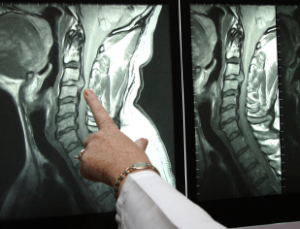Radiculopathy

Symptoms
Radiculopathy can result in pain near where the injured nerve is located. In addition, some sufferers feel a tingling, numbness and weakness in the area or a nearby extremity. So if the radiculopathy occurs in the neck, pain and discomfort may radiate down one or both arms and if it occurs in the lower back, it may radiate down one or both legs. When it affects the legs, it is also known as sciatica. Movements that pull on the affected part of the body, such as a quick reach, may sharpen the pain.
Diagnosis
Your physician will take a complete medical history, which includes asking numerous questions about your symptoms. He or she will examine the affected area and check on your strength, reflexes and sensation of feeling. Additional tests may be required as well. These can include X-rays to view spinal alignment and disks and an MRI to more clearly visualize the spinal cord and nerve roots. CT scans may also be used to obtain detailed views of the spinal bones and electromyelography, which helps the physician to study the electrical activity along the nerve.
Treatment
Conservative treatments are always the first options considered for radiculopathy. If the problem lies in the neck region, your physician may begin with a soft collar. This will limit the range of motion in your neck and rest the muscles. Physical therapy may be able to strengthen the muscles in the problem area, maximize flexibility with stretching exercises and take some pressure off of the injured nerve roots. There are medications that can help as well. Anti-inflammatories and oral corticosteroids can reduce pain and swelling. Steroid injections in the spine are sometimes used to decrease swelling too, allowing for healing to take place. In severe cases when pain does not respond, stronger prescription pain medications may be incorporated into the care plan. If these treatments cannot provide the patient with relief or symptoms are worsening, surgery will often be required. There are several types of procedures that can be used to correct radiculopathy, depending on the reason for your nerve problem and its location. Diskectomy with fusion is the most common and it can restore the alignment of the spine, reduce the compression on the nerves and support the affected area of spine. A laminoforaminotomy may be used to remove the segments of bone that are compressing the nerves. If the radiculopathy is caused by a degenerated disk, artificial disk replacement may be the best surgical option to remove the worn disk, relieve pressure on the nerves and restore height between the vertebrae.

